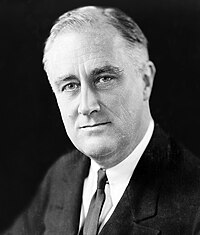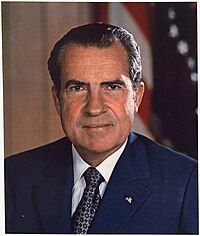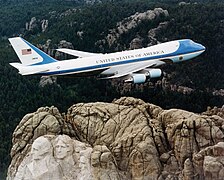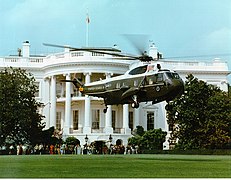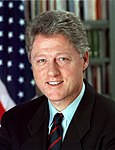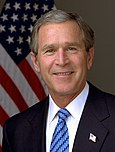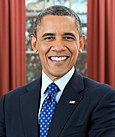President of the United States
The President of the United States (in English, President of the United States; acronym: POTUS) is the head of state and government of the United States. It is the highest political position in the country by influence and recognition. The president heads the executive branch of the federal government.
Among other powers and responsibilities, Article II of the United States Constitution charges the president with the "faithful execution" of federal law, makes the president the commander-in-chief of the Armed Forces, authorizes him to appoint executive officers and judicial with the advice and consent of the Senate, puts him at the forefront of US foreign policy, and allows the president to grant pardons or moratoriums.
The president is elected by indirect suffrage by an electoral college (or by the House of Representatives if the electoral college does not grant a majority vote to any candidate) for a four-year term. Since the ratification of the Twenty-second Amendment in 1951, no person may be elected to the office of president more than twice. In the event of the death, removal, resignation, or resignation of a president, the vice president assumes the presidency.
To date, there have been a total of forty-five inaugurations and forty-six presidencies. This occurs because President Grover Cleveland served two non-consecutive terms and is counted in chronological order as both the twenty-second and twenty-fourth president. Of the people elected to the position, four died during his tenure of natural causes, one resigned, and four were assassinated. The first president was George Washington, who was inaugurated in 1789 after a unanimous vote of the electoral college. William Henry Harrison had the shortest tenure in office, with just 32 days, and Franklin D. Roosevelt, with his 12 years in office, had the longest tenure and the only president to serve more than two mandates (he won the presidential elections four times).
The current sitting president is Democrat Joe Biden, who took office on January 20, 2021.
Since the beginning of the 20th century, the hegemonic role of the United States on the international political and economic scene has led the president of this country to be a figure known globally and, due to the country's status as the only superpower, in 2009 Forbes magazine described its owner as "the most powerful person in the world".
Origin
The Treaty of Paris (1783) ended the War of Independence and recognized the constitution of the Thirteen Colonies as the United States of America, but with an unstable governmental structure. The Second Continental Congress had drafted the Articles of Confederation in 1777, outlining a permanent Confederation, but giving the Confederation Congress (the only federal institution) little power to finance itself or to enforce its resolutions. In part, this reflected the anti-monarchical view of the revolutionary period, and the new American system was explicitly designed to prevent the rise of an American tyrant to replace the British monarch.
However, during the economic depression caused by the collapse of the continental dollar after the American Revolution, the viability of the American government was threatened by political unrest in several states, the efforts of debtors to use popular government to eliminate their debts and the apparent inability of the Continental Congress to meet the public obligations assumed during the war. Congress also seemed incapable of becoming a forum for productive cooperation among states, which encouraged trade and economic development. In response to this problem, a constitutional Convention was convened, initially to reform the Articles of Confederation, but which later began the design of a new system of government that would include greater executive power while retaining essential checks and balances with the idea of restricting any imperial tendencies in the presidency.
Persons who presided over the Continental Congress during the Revolutionary period, and under the Articles of Confederation, held the title "President of the United States in the Assembly Congress" and was often abbreviated as "President of the United States ». The office had little clearly defined executive power. With the ratification of the Constitution in 1787, a separate executive branch was created, headed by the President of the United States.
The executive authority of the president under the Constitution, tempered by control of the legislative and judicial branches of the federal government, was designed to solve the political problems faced by the newly created nation and to try to overcome future challenges, always preventing the rise to power of an autocrat in a nation wary of monarchical authorities.
Powers and duties
The United States Constitution and its subsequent Amendments set out the powers and duties of the president:
Article I - Legislative role
The first power vested in the president by the US Constitution is the legislative power of presidential veto. The so-called "Presentation Clause" requires that any bill passed by Congress be submitted to the president before it can become law. Once the legal norm has been presented, the president has three options:
- Sign it; the legislative bill becomes law.
- Watch it and return it to Congress with your objections; the bill does not become a law unless each House of Congress votes to cancel the veto with a favorable two-thirds majority of the House.
- Don't do anything. In that case, the president neither sign nor veto the legislation. After 10 days, excluded on Sundays, two situations can be given:
- If Congress is still in session, the bill becomes law.
- If it is not possible to return the proposal for having completed the Congress its session, the bill does not become law. This situation is often referred to as a "pocket break"pocket veto) for the president, leaving the bill "in his pocket" in that period, could not directly veto a law, but would do so in practice. James Madison was the first president to use the "pocket break" in 1812.
In 1996, Congress attempted to change the presidential veto power with the Line Item Veto Act. The legislation authorized the president to sign any spending bill into law at the same time that it eliminated certain spending items within the bill, particularly any new spending, any amount of discretionary spending, or any new limited tax benefit. If the president removed an article, Congress could pass that particular article again. If the president then vetoed the new legislation, Congress could override the veto with regular procedure, that is, with a two-thirds vote in both Houses. In the case Clinton v. New York City (1998), the US Supreme Court ruled that this modification of the presidential veto power was unconstitutional.
Article II - Executive powers
War and foreign affairs
Perhaps the most important of all presidential powers is his position at the helm of the United States Armed Forces as its commander-in-chief. While the power to declare war rests constitutionally with Congress, the president commands and directs his armies and is responsible for planning military strategy. The fathers of the Constitution were cautious in limiting the presidential powers in terms of the military; Alexander Hamilton explains it in his Federalist Essay No. 69:
The President is to be commander-in-chief of the army and navy of the United States.... It would amount to nothing more than the supreme command and direction of the military and naval forces... while that [the power] of the British king extends to the DECLARING of war and to the RAISING and REGULATING of fleets and armies, all [of] which... would appertain to the legislature.The president must be the commander-in-chief of the United States Army and Navy... This should be nothing more than the supreme command and leadership of the military and naval forces... while the [power] of the British king extends to the DECLARATION of war and the LEVANTAMIENT and the regulation of fleets and armies, all [these powers] which... would correspond to the legislative power.
Congress, in accordance with the War Powers Resolution of 1973, must authorize any troop deployment of more than 60 days duration unless Congress itself has declared war. In addition, Congress exercises some limitation on the presidential military power by its control and regulation of military spending.
Along with the military, the president is also in charge of foreign policy. Through the Department of State and the Department of Defense, the President is responsible for the protection of Americans abroad and foreign citizens in the United States. The president decides whether to recognize new nations and new governments and negotiates treaties with other nations, which become effective in the United States when approved by two-thirds of the Senate. The president can also negotiate "executive agreements" with foreign powers that are not subject to Senate confirmation.
Administrative powers
The president is the chief executive of the United States, and is at the head of the executive branch of government, whose responsibility it is to "see that the laws are faithfully executed." To carry out this duty, he is given control of the four million employees of the federal executive branch.
The president is responsible for nominating various members of the executive branch. Ambassadors, Cabinet members, and other federal officials are all nominated by the president and are appointed by and with the "advice and consent" of a majority of the Senate. Appointments made while the Senate is not in session are temporary and expire at the end of the next Senate session. The president can nominate some 6,000 appointments while he exercises his mandate.
The president's power to fire executive officers has long been the subject of debate. Generally, the president can remove executive officers at his discretion, however, Congress can reduce by decree the president's authority to remove commissioners of independent regulatory agencies and certain lower executive officers.
Legal powers
The president also has the power to nominate federal judges, including members of the United States Supreme Court and the Courts of Appeals. However, these appointments require the confirmation of the Senate and this can be a major stumbling block given the possibility that a president wanted to form a federal judiciary with a particular ideological position. The president can appoint judges to the United States district courts, but will often defer these appointments to senatorial courtesy, he can also grant pardons and pardons, as is often done just before the end of a presidential term.
So-called "executive privilege" gives the president the ability to withhold information from the public, Congress, and the courts when the matter involves national security. George Washington was the first to claim the privilege when the House of Representatives requested certain documents regarding the negotiation of the Jay Treaty with the Kingdom of Great Britain. Although the privilege is not listed in the Constitution or any other law, Washington's action created the precedent for privilege. When Richard Nixon tried to use it as a reason for not giving evidence to a congressional subpoena during the Watergate scandal, the Supreme Court ruled in United States v. Nixon, , that executive privilege did not apply in cases where a president was trying to avoid criminal prosecution. When President Bill Clinton tried to use executive privilege in the Lewinsky scandal, the Supreme Court ruled in Clinton v. Jones, , that the privilege could not be invoked in cases of civil litigation either. These cases established the legal precedent that executive privilege is valid, but the exact degree of the privilege is still pending clear definition.
Legislative capacity
Although the President of the United States does not have the ability to directly introduce legislation, he can play an important role in shaping it, especially if the President's political party has a majority in one or both Houses of Congress. Members of the executive branch cannot simultaneously hold their office and a seat in Congress, but it is common for them to write legislation and have a senator or representative introduce it for them. The president can significantly influence the legislative branch through the annual report, written or oral, which he is constitutionally required to present to Congress, and which is currently called the State of the Union Address. This speech often outlines the legislative offer for the coming year.
In accordance with Article II, Section 3, Clause 2 of the Constitution, the president may call one or both Houses of Congress for an extraordinary session. If both Houses do not reach an agreement on the date of the convocation, the president can designate a date for the meeting of the Congress. This power of the president to convene Congress in an extraordinary way was only exercised 27 times in the entire history of the United States. The last was held in 1948 by Harry Truman.
Election process
Eligibility
Article II, Section 1, Clause 5 of the Constitution establishes the necessary requirements to be considered eligible as president. A presidential candidate must:
- Be a citizen of birth of the United States;
- To be at least thirty-five years old;
- Have been a permanent resident in the United States for at least fourteen years.
Regarding the issue of United States citizenship, it is worth clarifying that Article II of the Constitution states that it is a requirement to be "a natural born Citizen, or a Citizen of the United States, at the time of the Adoption of this Constitution”, that is, a citizen by birth of the United States. The Fourteenth Amendment, adopted in 1868, defines in its Section 1, Clause 1 that «All persons born or naturalized in the United States, and subject to the jurisdiction thereof, are Citizens of the United States and of the State where they resides.”, that is, anyone born or naturalized in the United States is a legal US citizen, however, without the requirement of birth on US soil, they would not be eligible. This is a subject widely debated in the country, and for some columnists such as John W. Dean, former presidential adviser, it is an outdated constitutional clause that contradicts the spirit of the so-called "American dream" and conflicts with the "Statute of Liberty" itself. » American, which welcomes foreigners, but prevents them from accessing the highest position of responsibility in the country.
Under the Twenty-second Amendment, no one can be elected president more than twice. The Twenty-second Amendment also specifies that someone who serves more than two years as president or acting president, of a term for which another was elected president, can only run for president once. Constitutional scholars disagree on whether a A person who is no longer eligible for the presidency could be elected vice president, in accordance with the requirements set forth in the Twelfth Amendment.
The Constitution provides for the disqualification of some people from the presidency. Under Article I, Section 3, Clause 7, the Senate has the option, at its discretion, to disqualify convicted senior officials from other federal offices, including the presidency. Also, Section 3 of the Fourteenth Amendment prohibits any person who, having taken an oath to support the Constitution, and who subsequently rebelled against the United States, may be elected to serve as president, unless each House of Congress has withdrawn the disqualification by a favorable vote of two thirds of its members.
Nomination of candidates and campaign
The contemporary presidential campaign begins before the primary election, when the two major American political parties make a selection of candidates before their national nominating conventions, where the chosen one becomes the party's nominee for the presidency. Typically, the party's presidential nominee chooses a vice-presidential nominee and this choice is confirmed by the convention.
Candidates participate in nationally televised debates, which are generally restricted to the Democratic and Republican candidacies although third parties are sometimes invited, as was the case with Ross Perot in the 1992 debates. The nominees from each party they campaign across the country to explain their electoral agendas, win over voters and solicit campaign contributions. Most of the modern electoral process is centered around campaigning in so-called "swing states" (those in which a party does not historically have a clear majority), through frequent visits and media announcements.
Election and Oath
In the United States, the president is elected by indirect suffrage. A certain number of representative electors, collectively known as the Electoral College, officially elect the president. During "Election Day" (the Tuesday following the first Monday in November), the electorates of each of the states and the District of Columbia select these electors by ballot. Each state is assigned a certain number of voters, which correspond to the sum of delegates from that state in each of the Houses of Congress. In most states, the candidacy that receives the most votes wins all of the state's electors to vote in the Electoral College.
The winning electors meet on the first Monday after the second Wednesday in December, approximately six weeks after the election, to choose the President and Vice President of the United States. No constitutional provision or federal law requires voters to vote in accordance with the popular vote in their respective state, yet today it is rare for voters to disregard the popular vote and cast their electoral ballot for someone other than their party's candidate. After the vote, voters send a record of the vote to Congress. The vote is opened by the electors by the vice president, who acts in his capacity as president of the Senate and is read aloud in a joint session of both Houses of the incoming Congress, who was elected at the same time as the president.
The determination of who will be president depends on the votes of the Electoral College, not on who obtained the greatest number of popular votes in the country. However, only on five occasions (in the elections of 1824, 1876, 1888, 2000 and 2016) did the candidate who obtained the highest number of popular votes fail to win the majority of electoral votes and, therefore, his election as president. If no candidate obtains a majority of the electoral votes, the Twelfth Amendment provides that the choice of the president corresponds to the House of Representatives. The House has had to select the president twice, in 1800 and 1824.
In accordance with the Twentieth Amendment, the presidential term begins at noon on January 20 of the year following the election. This date, known in the United States as "Inauguration Day" (opening day), marks the beginning of the four-year term of both the president and vice president. Before being able to serve, he must perform an act of inauguration and, according to the Constitution, he is required to take the presidential oath:
I do solemnly swear (or affirm) that I will faithfully execute the Office of President of the United States, and will to the best of my Ability, preserve, protect and defend the Constitution of the United States.I solemnly swear that I will faithfully exercise the position of President of the United States, and, to the limit of my capacity, will preserve, protect and defend the Constitution of the United States.Article II, Section 1, Clause 8 of the Constitution.
Although not required, presidents have traditionally used a Bible to take the oath, adding at the end of the oath "So help me God!" (with God's help!). Similarly, although no provision of law requires that the oath of office be administered by a specific person, traditionally the president takes his oath before the chief justice of the United States Supreme Court.
Term and term limits
The terms of office of the President and Vice President of the United States are four years. Initially the Constitution did not set a limit on the number of terms, but few presidents ran for a third term. However, in 1940, Franklin D. Roosevelt ran for office and was elected to his third term (he was later elected to his fourth, but died a few months after his inauguration), becoming the only president to serve as president in more than two occasions. Prior to Roosevelt, Ulysses S. Grant wanted to run for a third term in 1880 after serving from 1869 to 1877, but failed to win his party's nomination. Theodore Roosevelt became president after the assassination of William McKinley and was subsequently elected in 1904 to a full term, serving in office from 1901 to 1909. He subsequently ran (for a non-consecutive term) in 1912, but lost Before Woodrow Wilson.
With the ratification of the Twenty-second Amendment in 1951, any person elected to the Presidency, and who has served as President, is prohibited from being re-elected more than once and if he has served as Acting President for more than two years of the term undefeated from its predecessor, being chosen more than once. Harry S. Truman, who held the presidency at the time of the amendment's ratification (which expressly exempted the president in office at the time of its entry into force from this limitation) also sought a third term before withdrawing from the election. from 1952.
Since the amendment's ratification, five presidents have served two full terms: Dwight D. Eisenhower, Ronald Reagan, Bill Clinton, George W. Bush, and Barack Obama, while Jimmy Carter, George H. W. Bush, and Donald Trump, they ran for re-election for a second term, but were defeated. Richard Nixon was elected to a second term, but resigned before completing it. Lyndon B. Johnson was the only president who under the amendment could be eligible to serve more than two terms, as he only served fourteen months after the assassination of John F. Kennedy. However he decided not to run in the 1968 election. Gerald Ford sought a full term after serving the last two years and five months of Nixon's second term, but was not elected.
Termination or disability
The position of president can become vacant due to various circumstances: death, resignation and dismissal.
| Presidential successor line | |
|---|---|
| 1 | Vice-Chairman |
| 2 | President of the House of Representatives |
| 3 | Pro tempore President of the Senate |
| 4 | Secretary of State |
| 5 | Secretary of the Treasury |
| 6 | Secretary of Defence |
| 7 | General Prosecutor |
| 8 | Secretary of the Interior |
| 9 | Secretary of Agriculture |
| 10 | Secretary of Trade |
| 11 | Secretary of Labour |
| 12 | Secretary of Health and Human Services |
| 13 | Secretary of Housing and Urban Development |
| 14 | Secretary of Transport |
| 15 | Secretary of Energy |
| 16 | Secretary of Education |
| 17 | Secretary of Veterans Affairs |
| 18 | Secretary of National Security |
Regarding impeachment, Section 4 of Article II of the U.S. Constitution provides that the House of Representatives may impeach senior federal officials, including the president, in cases of "treason, bribery, or other felonies or criminal offenses.” Following this process, Clause 6 of Section 3 of Article I of the Constitution grants the Senate the power to remove accused officials from office if two-thirds of its members vote guilty. Three presidents have been indicted by the House of Representatives, Andrew Johnson in 1868, Bill Clinton in 1998, and Donald Trump in 2019 and 2021, although none were subsequently convicted by the Senate.
Under Section 3 of the Twenty-fifth Amendment, the president may transfer the presidential powers and duties to the vice president, who would then act as acting president, filing a declaration with the speaker of the House of Representatives and the president pro tempore of the Senate stating the reasons for the transfer. The president regains the presidential powers and duties when he presents to both representatives of Congress a written statement declaring such resumption. This transfer of powers can occur for any reason the president deems appropriate. In 2002 and 2007, President George W. Bush briefly transferred presidential authority to Vice President Dick Cheney. Both times it was due to a medical process that required Bush to be sedated; Bush regained presidential power the same day.
Section 4 of the Twenty-fifth Amendment contemplates the possibility of the transfer of presidential powers to the vice president if the latter and the majority of the Cabinet transmit to the speaker of the House of Representatives and the president pro tempore of the Senate a declaration of presidential incapacity to perform the job. In this case, the vice president would assume the presidential powers as interim president; however, the president may reject his disqualification and continue in office. If the vice president and the Cabinet challenge this decision, it is then Congress, which must meet within two days if it is not already in session, who must decide whether or not the president is incapacitated to hold office.
The Constitution of the United States mentions the resignation of the president, but does not regulate the manner of executing such resignation or the conditions for its validity. By agreement of Congress, the only valid proof of the presidential decision is a written document stating his resignation signed by the president himself and delivered to the office of the Secretary of State. On August 9, 1974, facing likely removal in the midst of the Watergate scandal, Richard Nixon became the only president to resign from office.
As in the case of resignation, for non-acceptance of the post it is also sufficient to present a document to that effect before the Secretary of State.
The Constitution specifies that the vice president should be the presidential successor in the event of a vacancy in the position due to death, resignation, resignation, disqualification, dismissal or any other cause. If both the office of president and vice president are vacant or filled by persons unfit for office, the speaker of the House of Representatives would fill the position as acting president. The presidential line of succession continues with the president pro tempore of the Senate, followed in turn by each member of the Cabinet in an established order, as long as they meet the constitutionally determined requirements to be president.
Salary and benefits
| Year of establishment | Salary (dollars) | Equivalence in 2017 |
|---|---|---|
| 1789 | 25 000 | 718 000 |
| 1873 | 50 000 | 1 060 000 |
| 1909 | 75 000 | 2 080 000 |
| 1949 | 100 000 | 1 030 000 |
| 1969 | 200 000 | 1 340 000 |
| 2001 | 400 000 | 554 000 |
| Sources: | ||
In 1789, while initially disagreeing with receiving a salary for his services, the First United States Congress agreed to pay George Washington a salary of $25,000 a year (approximately $566,000 in 2009), a really high salary for the time, although the government at that time did not provide an official mansion and Washington had to assume the high expenses of a presidential residence with that salary, so he stated that the salary was barely enough to cover these expenses.
The presidential salary has undergone successive increases over the years and in 1999, when Bill Clinton was president, Congress approved the current presidential salary of $400,000 per year, which took effect in 2001. (2005) a $50,000 spending account, $100,000 tax-free for travel, and a $19,000 personal spending account.
Prior to 1958, when the presidents ended their terms, they did not receive any pension; however, starting that year, with the Former Presidents Act (3 U.S.C. § 102), Congress approved that presidents Outgoing workers will begin to receive a lifetime pension of $25,000 per year, in addition to an office and staff. This pension has been increasing ever since with the approval of Congress. Former presidents receive a pension based on the salary of the current administration's cabinet secretaries, whose salary is $193,400 as of 2009. The widow of a president is entitled to a pension of $20,000 per year, if you do not have another pension.
Since 1800, when John Adams was in office, the White House in Washington D.C. has served as the official residence of the US president. While in office, you have the right to use its facilities and personnel, including medical care, recreation, domestic services, and security service. The Thurmont Naval Support Facility, popularly known as Camp David, is a military installation in Catoctin Mountain Park, a recreational area located in Frederick County (Maryland), on the outskirts of Washington D. C., which is currently used as the official rest residence of the president and his guests.
The United States Secret Service is entrusted with the protection of the President and his family. As part of their protection, presidents, first ladies, their children and other immediate family members, as well as other relevant people and places, are assigned a code name by the Secret Service. The use of these code names was for security reasons at a time when electronic communications were not commonly encrypted, as they are today; today these codenames are simply used for tradition, as well as for brevity and clarity.
When he makes long-distance trips, the president uses one of two aircraft identified by the US Air Force as the VC-25 (a heavily modified military version of the civilian Boeing 747-200B model) designated by the callsign " Air Force One" when the President is using them, which are lavishly equipped and in which he can carry out all of his duties. The President also uses a Marine Corps helicopter, identified as " Marine One” when the president is on board. For ground travel, he uses an armored limousine based on an extensively modified Cadillac chassis, sometimes referred to as the "Cadillac One " after the presidential plane.
Post-presidency
Some presidents have had significant careers after leaving office. Such is the case of William Howard Taft who was president of the Supreme Court, or that of Herbert Hoover with his work in the reorganization of the government after World War II. Grover Cleveland, whose reelection bid failed in 1888, was later reelected president four years later, in 1892. Two former presidents served in Congress after leaving the White House; John Quincy Adams was elected to the House of Representatives, where he remained for seventeen years, and Andrew Johnson returned to the Senate in 1875. John Tyler served in the Confederate States Provisional Congress during the Civil War and was elected to the Confederate House of Representatives, although he died before it was reunited. More recently, Richard Nixon has made numerous trips abroad, including to the People's Republic of China and Russia. Jimmy Carter has served as an international mediator, advocate for human rights around the world, and was awarded the 2002 Nobel Peace Prize. Bill Clinton He has also carried out mediation and negotiation efforts at the international level, as in the case of his efforts for the release of two American journalists, Laura Ling and Euna Lee, in North Korea. Bill Clinton has also been active in politics, such as in the case of the 2008 Democratic presidential primaries in support of his wife, Hillary Clinton.
Until 1997, all former presidents and their families had Secret Service protection until the president's death. The last president to receive lifetime protection from the Secret Service after this legislative change was Bill Clinton; George W. Bush and all subsequent presidents would be protected by the Secret Service for up to ten years after the end of their term. However, on January 10, 2013, President Obama signed into law that reinstated protection of the Secret Service for life for himself, George W. Bush, and all subsequent presidents. If the spouse remarries, they lose their right to protection by the Secret Service.
Presidential Libraries
Every president since Herbert Hoover has created a place to preserve and make available to the public documents, archives, collections and other historical objects related to their terms of office, which, although it is not exclusively a library, is known as the Presidential Library. The Libraries are established and maintained by the National Archives and Records Administration (NARA). There are currently thirteen presidential libraries in the NARA system. There are also several presidential libraries maintained by state governments and private foundations, such as the Abraham Lincoln Presidential Library and Museum, which is run by the state of Illinois.
Living Former Presidents
There are currently five living former presidents of the United States. The most recent former president to die was George H. W. Bush (1989-1993), on November 30, 2018. The living former presidents, in order of service, are:
Contenido relacionado
Philosopher Stone
Aragon County
26th century BC c.



